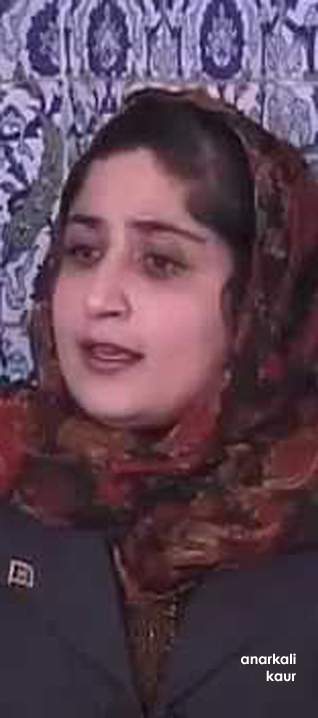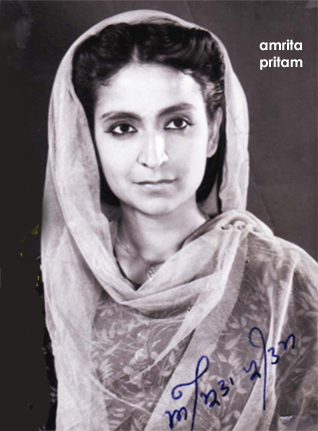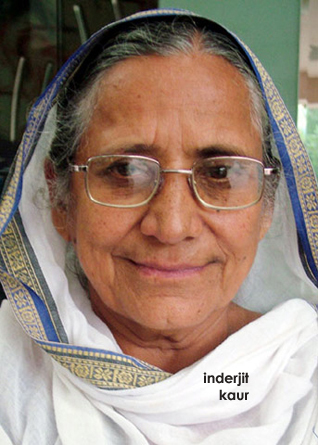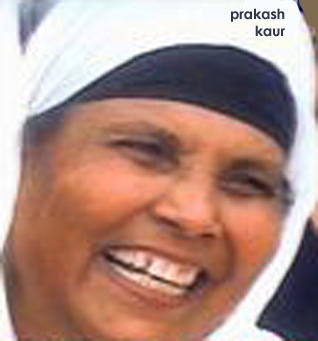Our Heroes
10 Sikh Women You Should Know And Why You Should Know Them
by VALARIE KAUR
If you ask Sikhs about their religion, the first thing you will hear is belief in the Oneness of God.
The second is that Sikh men wear turbans to cover their long hair, an article of faith which tragically became a target after 9/11 (See, I just did it).
But if you linger a minute longer, you will hear us beam about the equality of women in our faith. Unlike in most other religions, our scriptures are explicit about women as equal in the eyes of God.
What if you asked for names of famous Sikh women?
You will hear a short pause. Then, a slight effort in concentration, before: Ah ha! There's Mata Tripta, the mother of the first Guru! And Mata Nanaki, the sister of the first Guru! And Mata Khivi, wasn't she the second Guru's wife? You will hear an earful of mothers, sisters and wives of the Ten Gurus, or Teachers of the Sikh faith in the 15th and 16th centuries. As the list ends there, you may begin to sense there is something amiss.
It's time to confront the gap between our ideals and how we live them.
Sikh-Americans like me talk a great deal about women's equality, but we are steeped in an old patriarchal culture that makes us complicit in the erasure of women, past and present. Even the few famous women in our history are defined in relation to their men. Their full contributions as thinkers, poets and warriors unto themselves are eclipsed by the men they supported.
The real life consequence? Sikh girls today are told they're fully equal, and yet many are expected to carry out traditional gender roles - with few role models to suggest otherwise.
We would never tell you this, of course. You can't blame us. There are so few of us, it's hard to air our community's problems - especially after 9/11, when explaining that "Sikhism" is a religion in the first place became a matter of daily survival.
In fact, as a third-generation Sikh-American activist, it took me nearly a decade after 9/11 even to begin talking about women again. After the terrorist attacks, we women tacitly agreed to put our issues on hold. We needed to protect our men first - our fathers and brothers and husbands and sons whose turbans and tanned skin marked them as primary targets for hate in the years after 9/11.
This was a mistake. As we waited (and are still waiting) for the discrimination to pass over us, some of the cultural dysfunctions in our community worsened.
Women are girls are always the first casualties within minority communities under siege.
That is no different in ours.
Just as in most patriarchal traditions around the world, the bodies of women have been considered vessels of honor in Punjabi culture. When riots and massacres swept Punjab during the 1947 Partition of Punjab and the subcontinent, some Sikh men poisoned their daughters before letting them fall into the hands of Muslim attackers - there had been widespread reports of mutilation and sexual brutalization of women.
Today in America, while many Sikh families champion education and freedom for sons and daughters alike, others have tightened control over women and girls in the 9/11 decade. In the worst anecdotes, domestic violence is an outlet for men who bear racism on the street, intermarriage an act of betrayal, and honor killings an actual threat.
But there's another story too.
The call for liberation pulses through the Sikh tradition: it's in our scriptures and songs and stories. Hearing the call, a new generation of Sikh women has emerged as lawyers, artists, entrepreneurs, doctors, filmmakers and more. They have found brave new ways to defend their communities while offering their own unique voices to public discourse.
I am proud to call them my contemporaries - they are sources of inspiration, wisdom and leadership in their communities who deserve to be known.
Here are 10 Sikh women who embody the highest Sikh ideal of the warrior-saint. Half are legends from early history - women who we will never fully know but whose deeds ignite our imagination as the first female warrior-saints. Half are modern-day heroines - each one stands for hundreds of Sikh women who are blazing their own paths as the warrior-saints of our era.
My hope is that the next time you ask a Sikh on the street about his or her religion, he/she will be able to name all these women. And you will already know their names.
I THE FIRST SIKH: NANAKI (1464 - 1518)
Born in Chahal village (Lahore, Punjab - now in Pakistan), Mata Nanaki loved and nurtured her younger brother Nanak. In 1469, Nanak experienced a divine vision as a young man and became the first Guru or "teacher" of what is now the Sikh faith. Nanaki was the first to follow him and is celebrated as the First Sikh, which literally means "disciple" or "seeker of truth."
II THE FIRST TO SERVE LANGAR: KHIVI (1506 - 82)
Mata Khivi followed Guru Nanak and prepared food for all who came to
hear the Guru's spiritual discourse. When her husband Angad became the second
Sikh Guru, she presided over langar, a free and open kitchen, serving food to rich and poor of all castes, faiths and backgrounds. Today, every Sikh gurdwara in the world serves langar to the community and is open to all. Sikh and non-Sikh alike.
III THE WARRIOR-SAINT: BHAGO (late 1600s - early 1700s)
Born in Jhabal village (now Amritsar, Punjab), Ma-ee Bhago
grew up in a time when the 10th Guru, Gobind Singh, fought to
defend Sikhs against the tyranny of the Mughal regime and regional Hindu hill chiefs. During a great siege
in 1705, Bhago rallied 40 deserters and led them into battle
herself, sword in hand. They died fighting and became known as the Chaali
Muktey - the Forty Liberated Ones. Later, Bhago became the Guru's
bodyguard, donning a turban and dressing in warrior attire.
Today, she is revered as a warrior-saint.
IV COMMANDER-IN-CHIEF: SADA KAUR (1762 - 1832)
Rani Sada Kaur became a young widow when her husband was killed in a
battle. She used the moment to transform
herself into a warrior, donning a turban, armor and weaponry. She
commanded battles and laid the foundation for the Sikh empire, which
spanned the Punjab from 1799 to 1849. She closely advised her son-in-law
as guided him as he became the first Emperor of the new Sikh empire - Maharaja Ranjit
Singh.
V FREEDOM FIGHTER: MAHARANI JIND KAUR (1817 - 63)
Married to Maharaja Ranjit Singh, Jind Kaur was the first female freedom fighter in the struggle to oust the British from the subcontinent. After Ranjit Singh's death, the British annexed the Punjab through bribery and treachery. Jind Kaur's revolutionary speeches and rallying cries rattled the British who imprisoned her. She escaped - a dramatic saga in itself - and lived in exile in Nepal. Later, when finally allowed to see her son, the exiled Maharaja Duleep Singh who had been taken away when still a child, she died shortly thereafter in England in 1863 at the age of 46. She is credited for sowing the seeds of the subcontinent's struggle for independence.
VI THE GREAT POET: AMRITA PRITAM (1919 - 2005)
She was the leading poet of the subcontinent in the 20th century. She is the first
prominent woman Punjabi poet, novelist, and essayist, equally loved on
both sides of the India-Pakistan border. With a career spanning six
decades, Amrita Pritam produced more than 100 books. She represents the
rise of Sikh women in the humanities - writers, artists, filmmakers
and scholars.
VII THE GREAT SOCIAL WORKER: DR INDERJIT KAUR (1942 - )
A doctor by training, Inderjit Kaur is the President of the Pingalwara Charitable Society in Amritsar, Punjab - a famous refuge for the poor, handicapped, diseased, and mentally ill. Since 1992, she has carried the legacy of its founder, Bhagat Puran Singh, with her own bold leadership. She stands in for countless Sikh women - doctors, nurses, health-care advocates, volunteers -- who selflessly care for the sick and poor.
VIII UNIVERSAL MOTHER: PRAKASH KAUR (1951 - )
In a country (India) notorious for female infanticide, Prakash Kaur runs a house in Jalandhar, Punjab for 60 abandoned girls. She was abandoned herself as a child- found a few hours old in a drain. Since 1993, she has rescued and raised unwanted and unclaimed newborn girls. She represents the many Sikh women fighting for women and girls against abandonment, domestic violence, sexual assault and forced marriage.
IX CIVIL RIGHTS LAWYER: AMRIT SINGH (1969 - )
A formidable civil rights lawyer, Amrit Singh was one of the
fiercest U.S. critics of the torture and abuse of prisoners under the
Bush Administration. As an ACLU attorney, she litigated cases on
torture, indefinite detention and post-9/11 discrimination. She now
serves at the Open Society Justice Initiative. Her father is the 13th
and current Prime Minister of India, Manmohan Singh. Amrit Singh
represents a new generation of Sikh women lawyers, wielding the law as
sword and shield in the civic battlefield.
X THE SENATOR: DR ANARKALI KAUR HONARYAR (1984 -)
Anarkali Kaur is a human rights advocate and Senator in Afghanistan. As one of a dwindling population of several thousand Sikhs remaining in war-torn Afghanistan, she fights for the civil rights of minorities and women. When the Taliban was overthrown in 2001, she joined the Grand Council, Loya Jirga, to elect the interim government, and then helped draft the country's new constitution. She serves as the first non-Muslim woman member in the Lower House of Parliament. In 2009, at 25 years old, she was voted "Person of the Year" by Radio Free Europe's Afghan chapter, becoming a household name in Kabul. A modern-day "Ma-ee Bhago," Arnakali Kaur represents the rise of fearless modern-day Sikh warriors.
[Courtesy: Huffington Post. Edited for sikhchic.com]
March 23, 2012
Conversation about this article
1: Pritam Singh Grewal (Canada), March 23, 2012, 8:18 AM.
Well done! Reminds us of the great contributions of our women throughout history, all the way to the present day.
2: Sandeep Singh Brar (Canada), March 23, 2012, 10:29 AM.
Some amazing Sikhs in that list. One glaring omission and one of the greatest Sikhs of the post-Guru era is Mata Sundri, Guru Gobind Singh's wife. In the dark days that followed the Guru's death, it was Mata Sundri's leadership that held the Sikhs together. Things were starting to factionalize and some Sikhs had started regarding Banda Singh Bahadar as the successor to Guru Gobind Singh, other Sikhs had started following an adopted son of Guru Gobind Singh as Guru. It was Mata Sundri's guidance and firm insistence that there could be no living successor or new Guru and her control of the faction loyal to Guru Gobind Singh that eventually won. Imagine how different things would have been if Mata Sundri had not been there. It was also Mata Sundri who appointed scholar Bhai Mani Singh as the head Granthi at Darbar Sahib 13 years after the Guru's death and asked him to make an effort to collect the Guru's poetry - an effort that resulted in the Dasam Granth.
3: Bicky Singh (Ontario, Canada), March 23, 2012, 6:30 PM.
I was also surprised to see that Mata Gujri was not on this list. During the last days of her life, the instruction and history that she provided to the chhotey Sahibzaadey were pivotal in the events that followed.
4: Valarie Kaur (New York, U.S.A.), March 24, 2012, 1:50 PM.
I'm glad that you've raised awareness of Mata Sundri and Mata Gujri. For this piece, I sought to choose five names from early history and five modern-day heroines. It was a tough call, and I hope that this list continues to inspire people to bring up more names of Sikh women, past and present. Thanks!
5: Tejinder Singh Hansra (Australia), March 25, 2012, 3:27 AM.
Add these to the last five ... Harita Kaur Deol, Kamaljit Kaur Sandhu, Amrita Shergill, Snatam Kaur Khalsa ... I could add a few more trail blazers. The author, Valarie Kaur, is herself a trail blazer in her own right.
6: Panthratan Singh (London, United kingdom), May 28, 2012, 10:58 AM.
I believe Bibi Balwant Kaur from Birmingham should also be added to this list. She has devoted most of her life to charity work and has a close bond with Bibi Parkash Kaur. Her work has covered needy areas in Somalia, Ethiopia, 1984 India, and much more. I thought the sangat should be aware of such a kind-hearted, generous and selfless human.
7: Sarbjit Singh Kang (Surrey, British Columbia, Canada), October 01, 2012, 11:02 PM.
Why does no one know anything about Rani Sahib Kaur of Patiala? When Nabha, Jind and other kingdoms were willing to kow tow to the Marathas, she alone stood up to them. With only an army of 10,000 Sikhs, she defeated a 100,000-strong Maratha army equipped with superior gun-power. In history, this compares with the victory of the 10,000 Greeks over the 100,000 Persians in 490 BC in the battle of Marathon.






